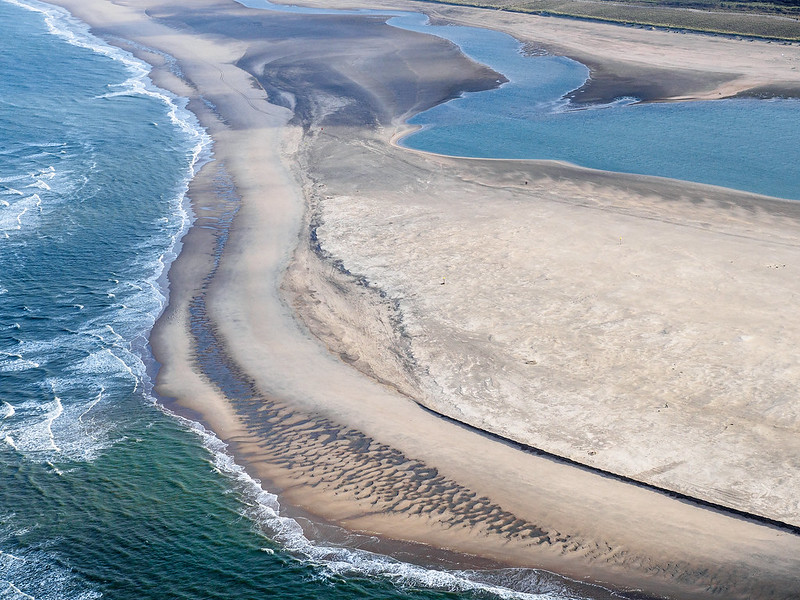Excerpt:
As sea levels rise, engineers are using massive Dutch-inspired sand sculptures to protect shorefront settlements...
The coastline of West Africa’s Gulf of Guinea is eroding faster than almost any other place in the world, with severe consequences for a population that is clustered by the water. According to a recent study, almost two-thirds of the region’s coastal settlements face severe economic and health disruptions from sea-level rise — most notably in the Nigerian megacity of Lagos, which sits on a marshland just a few feet above sea level. The World Bank estimates that the impacts of erosion could wipe out as much as 5 percent of the region’s gross domestic product.
Benin is in particularly dire shape: Parts of the country’s shoreline are eroding by as much as 45 feet every year, and miles of beach have vanished since the turn of the century. The erosion has washed out roads, disrupted the livelihoods for local fishermen, and carved up beaches that are major tourist attractions. The national government’s previous efforts to control land loss with concrete sea walls and rock structures didn’t do much to slow down the rate of erosion.
So when the World Bank gave the Beninese government $60 million in 2018 to pursue a raft of erosion solutions, its leaders opted to build a sand motor in a popular beachfront area where erosion has disrupted fishing and tourism. The dredging firm Boskalis built the project last May, vacuuming up more than 8 million cubic yards of sand to build a motor about one-third the size of the original one in the Netherlands…
A “sand motor” isn’t an actual motor — it’s a sculpted landscape that works with nature rather than against it. Instead of rebuilding a beach with an even line of new sand, engineers extend one section of the shoreline out into the sea at an angle.. Over time, the natural wave action of the ocean acts as a “motor” that pushes the sand from this protruding landmass out along the rest of the natural shoreline, spreading it down the coastline for miles.
While sand motors require much more upfront investment than normal beach nourishment — and many times more sand — they also protect more land and last much longer. Developed countries such as the Netherlands and the United Kingdom are turning to these megaprojects as an alternative to repeated nourishment, and the World Bank is financing a sand motor in West Africa as part of a billion-dollar adaptation program meant to fight sea-level rise. But these massive projects only work in areas where erosion is not yet at a critical stage. That means they’re unlikely to show up in the United States, where many coastal areas are already on the point of disappearing altogether…
West African countries have also used money from the World Bank to build rock groins, mangrove forests, and traditional nourishment projects. The bank hopes to monitor all these projects over the coming years to see which are most effective at combating erosion, then scale those solutions for the entire region. If the new sand motor in Benin survives for as long as the Dutch version has, the bank may try to replicate its success with more mega-nourishment projects in other parts of the world.
But this intervention will only work if countries like Benin also try to shift their development away from the water’s edge, according to Rob Young, a professor of geology at Western Carolina University and a leading expert on shoreline erosion.
“The Dutch made two choices,” he said. “One was, ‘We’re going to protect as much of the country from storm surge as we can.’ Number two was, ‘We’re going to get infrastructure out of the lowest lying areas, and we’re not going to build new stuff in stupid places…”
Young says…that the sand motor will only be useful for countries that can also shift development inland as part of a more comprehensive climate adaptation plan, as the Dutch did.
“In the U.S. we have lots of coastal resort communities where the houses are on the edge of the sea, right now, and we’re scrambling to keep sand in front of them,” he said. “If you look at what is down drift of the sand motor on the coast of Holland, they don’t have buildings teetering on the edge.”
Zandmotor (09-13-2016):
The Sand Motor Five years of Building with Nature
This video shows the results of the first five years of research on the Sand Motor. The development of the coast near the Sand Motor is helping to widen the coastal zone and it is progressing as planned. A dynamic nature area has been created. In addition, the Sand Motor has clearly resulted in an area with considerable value for leisure activities that was not present previously. In terms of the design and the process, the concept of the Sand Motor is a tool that fits in with the Dutch strategy of maintaining the coast with sand. In addition, the Sand Motor has given an impetus to national knowledge development and it is an internationally renowned icon of innovation.
Zandmotor (07-01-2021):
The Sand Motor Ten years of Building with Nature
Results of the Sand Motor research after 10 years: – The Sand Motor contributes to long-term coastal protection, even though the growth of new dunes has become clearly apparent in recent years. – The Sand Motor has generated attractive space for nature and recreation in the Delfland landscape is beyond dispute. But only temporarily, for as long as the Sand Motor exists. – The Sand Motor has undeniably contributed to knowledge and innovation in coastal maintenance and is an inspiration for other coastal protection projects.
SAND MOTOR CONGRESS
Delft, The Netherlands, 1 July 2021









